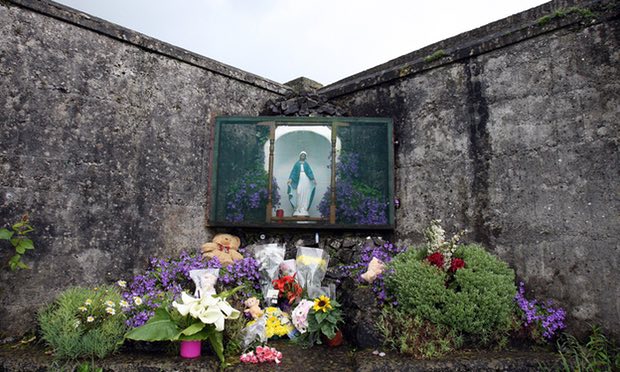Survivors of Ireland’s Mother and Baby Scandal Deserve Justice
By Tanya Gold
It is true, as survivors said it was. Under a small patch of grass by a playground in Tuam, County Galway, Ireland, the bodies of the children who died in the local Mother and Baby home lie in unmarked graves. The Mother and Baby homes of Ireland – the last of which closed in 1996 – were run like punishment hostels for unmarried pregnant women. Their children were taken for adoption, fostering or the horror of the industrial schools, or they died in their thousands, of malnutrition and neglect. In some cases the bodies were used for dissection in medical schools. This was veiled until two years ago when an amateur historian, Catherine Corless, learnt that 796 children had died at Tuam between 1925 and 1961; but where, she asked, were the graves? An inquiry was established and has now partially excavated the Tuam site. (The home has been replaced with a housing estate. Hence the ghoulish – and preposterous – playground.) Remains of children aged from those prematurely born to three years old have been found; Corless, then, is vindicated. You might say that, for survivors, stonewalled and ignored by the Irish state and Catholic church for decades, denied their birth records and medical histories – essentially, their identities – and thwarted in their attempts to find their families, this is a victory. Enda Kenny, the Irish prime minister, has called the findings “appalling”, and the Tuam site “a chamber of horrors” and that is a major concession. Bitter, yes, but an acknowledgment of the truth, even if it took the dead to say it. Survivors dispute this. It is not a victory to them, but an opportunity for further insult. The most shocking fact is this: about half of the adopted people and their mothers have been placed beyond the scope of the inquiry. There is, so far, nothing for them – no possibility of apology, financial settlement, memorial, medical history or opportunity for healing – and unless the inquiry radically expands, there never will be. Advertisement It deserves repetition: these are, in many cases, ruined lives. Much of the press likes to tell happy tales of families reunited, but this is retrospective and duplicitous self-expiation; it is sentimental. What was taken cannot be returned; restorative justice is a pleasing phrase and idea, but it is meaningless. That was always the point of the forced adoptions, after all: it was, explicitly, a punishment for transgression, and it was for life. One mother took a job as a cleaner near the Tuam home, and called in often to ask for custody of her son. She was always denied. An adoptee will often find a birth mother unwilling to meet him or her – many of the mothers have post-traumatic stress disorder. One woman I spoke to was telephoned by a stranger to say that her son, whom she had not seen since his babyhood, had killed himself. Look to the experience of Philomena Lee and her son Michael Hess, who, suffering with Aids, asked to be buried after his death in the grounds of the institution where he was born, so that his birth mother could one day find him. (They had tried to contact each other, but were thwarted by the nuns who ran the home.) Lee believes that the failure to be reunited with her son before he died was no accident. The inquiry will deal with the 35,000 inmates and children of the nine homes, and a small number of associated institutions operated by various religious orders on behalf of the state – plus a few county homes. Some of these orders – such as the Sisters of Bon Secours and the order of the Sacred Heart of Jesus and Mary – are still active, and thriving; the Bon Secours, for example, is wealthy enough to hire a public relations consultant who, two years ago, denied the existence of the burial pit at Tuam. But there is a second web of institutions that also removed children from their mothers. These included private nursing homes, public hospitals and so-called holding centres and orphanages for children who were not orphans; or, if they were, the state had made them so. Other children were taken from private homes, or by small adoption agencies and societies. One – the Catholic Rescue and Protection Society – operated in the UK under the auspices of a Dublin priest. Its job was to return fleeing pregnant women to Ireland, and the homes. One woman made this journey at full term. If you seek evidence of the physical welfare of these women and their children, look only to her testimony, and the burial pits. The tiny county home in Thomastown, County Kilkenny, for example, is included in the inquiry, but it closed in 1957 and activists are unaware of a single living survivor; the inquiry is, essentially, investigating an empty building. The Temple Hill holding centre, however, closed in the 1980s and has thousands of living survivors who, unless they later entered a Mother and Baby home, are excluded. The final report of the inquiry, due in February 2018, therefore, will be partial and flawed unless, as activists hope, it agrees to change its scope now. It if doesn’t, the Dail should intervene. Some of the survivors are ageing and in poor health; some have died since the inquiry began. The community doesn’t want a hierarchy of victims with so many left behind, but justice for all.
|
.
Any original material on these pages is copyright © BishopAccountability.org 2004. Reproduce freely with attribution.
